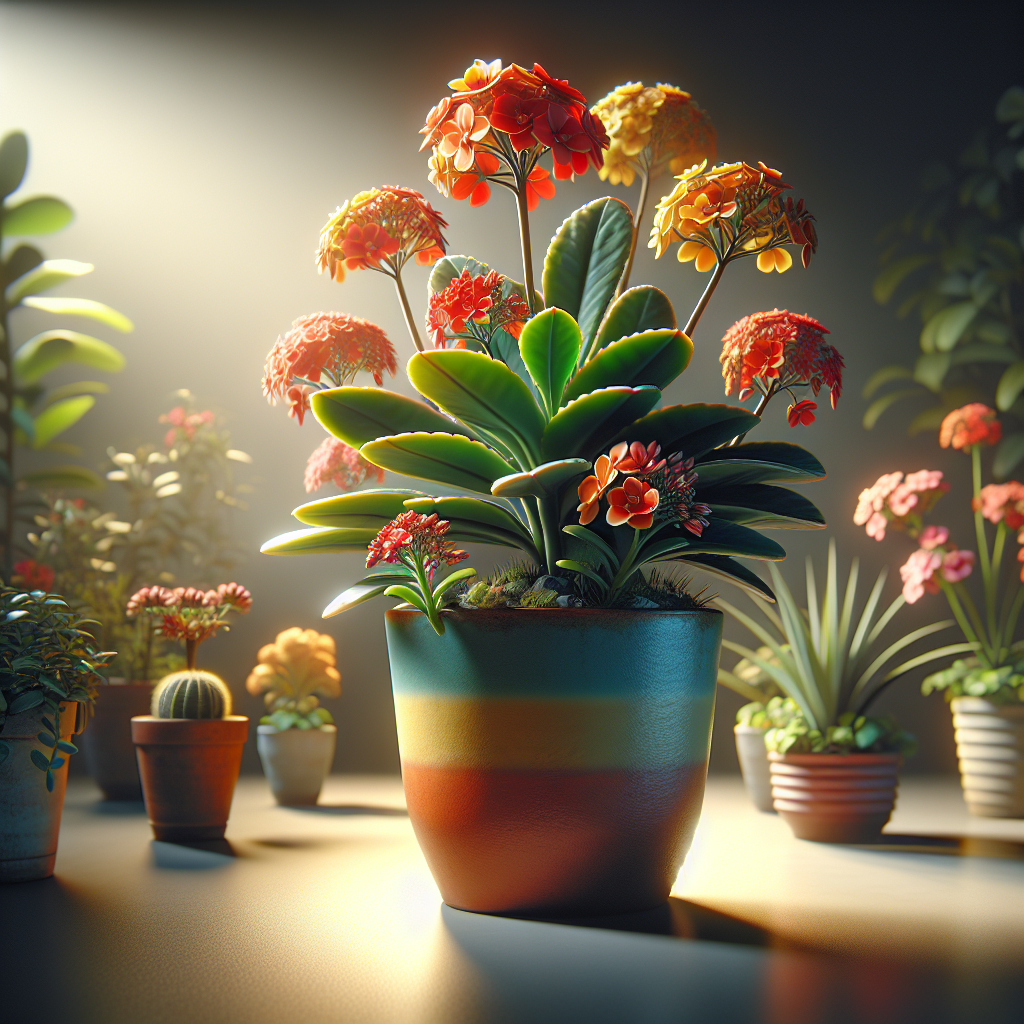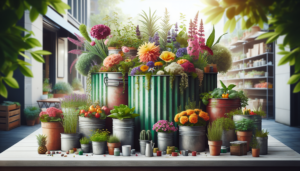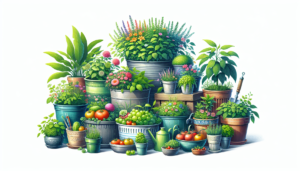
Container gardening is a delightful and convenient way to bring the beauty of nature right to your doorstep. And what better plant to accompany you on this gardening journey than the vibrant and versatile kalanchoe? Whether you are an experienced gardener or a complete novice, this ultimate guide will provide you with the essential tips and tricks to successfully cultivate kalanchoe in containers. From choosing the right pot and soil mix to watering and fertilizing techniques, we’ve got you covered. Get ready to enjoy the stunning blooms and lush foliage of kalanchoe all year round in your very own container garden.
Choosing the Right Container
Size
When choosing a container for your Kalanchoe, it’s important to consider the size of the plant and its roots. A container that is too small may restrict root growth and lead to stunted plants, while a container that is too large can hold excess water and drown the plant. As a general rule, select a container that is about 1-2 inches larger in diameter than the current size of your Kalanchoe.
Material
The material of the container plays a crucial role in the well-being of your Kalanchoe. Porous materials, such as terracotta or clay pots, allow for better drainage and aeration of the roots. They also help prevent overwatering and the risk of root rot. Alternatively, plastic or resin containers are lightweight, durable, and retain moisture well. Consider the climate and watering habits in your area when choosing the material for your Kalanchoe container.
Drainage Holes
Proper drainage is essential for the health of your Kalanchoe. Ensure that your chosen container has drainage holes at the bottom to allow excess water to escape. Without adequate drainage, the roots can become waterlogged, leading to root rot and the eventual demise of the plant. If your container doesn’t have pre-drilled holes, consider drilling them yourself or placing a layer of gravel at the bottom to facilitate drainage.
Selecting the Perfect Location
Sunlight Requirements
Kalanchoe plants thrive in bright, indirect sunlight. As you plan the location for your container, choose a spot that receives at least six hours of sunlight per day. If you live in a particularly hot climate, consider providing some shade during the hottest part of the day to prevent your Kalanchoe from scorching. A well-lit area will ensure healthy growth and vibrant blooms.
Temperature Considerations
Kalanchoe is a tropical succulent that prefers warm temperatures between 60°F and 85°F (15°C to 29°C). Avoid exposing your Kalanchoe to frost or extreme cold, as it can damage or kill the plant. If you live in a region with cold winters, it’s best to keep your Kalanchoe indoors or provide protection during colder months.
Shelter from Elements
While Kalanchoe is a hardy plant, it can suffer from damage caused by strong winds or heavy rains. If your area experiences frequent gusts of wind or heavy downpours, consider placing your Kalanchoe container in a sheltered spot, such as against a wall or under a covered porch. This will help to protect the delicate flowers and prevent the plant from toppling over.
Preparing the Container
Cleaning and Disinfecting
Before planting your Kalanchoe, it’s crucial to clean and disinfect the container to prevent the spread of diseases or pests. Wash the container with warm, soapy water and rinse thoroughly. For an extra layer of protection, you can sanitize the container by soaking it in a solution of 1 part bleach to 9 parts water for about 10 minutes. Rinse well afterwards to remove any residual bleach.
Adding Potting Mix
Choose a well-draining potting mix specifically formulated for succulent plants. These mixes typically contain a combination of peat moss, perlite, and sand. Fill your container with the potting mix, leaving enough space at the top to accommodate the Kalanchoe plant without overcrowding the roots. Gently pat down the soil to eliminate any air pockets.
Fertilizing the Soil
To ensure optimal growth and flowering, it’s essential to provide your Kalanchoe with the necessary nutrients. Use a balanced, water-soluble fertilizer formulated for succulent plants. Follow the instructions on the packaging for the correct dilution ratio and frequency of application. Avoid over-fertilizing, as this can lead to burnt roots or excessive growth without blooms.
Planting Kalanchoe
Choosing Kalanchoe Variety
There are numerous varieties of Kalanchoe to choose from, each with its own unique colors and growth habits. Some popular varieties include Kalanchoe blossfeldiana, Kalanchoe luciae, and Kalanchoe tomentosa. Consider the size of the plant, as well as the color and shape of its flowers, when selecting your Kalanchoe variety. Choose a variety that suits your personal taste and matches your desired color scheme.
Spacing and Arrangement
When planting multiple Kalanchoe plants in a container, it’s important to consider their spacing requirements. As a general guideline, leave about 6-8 inches of space between each plant to allow for proper air circulation and growth. This will prevent overcrowding and reduce the risk of diseases. Arrange the plants in an aesthetically pleasing manner, taking into account their mature size and growth habit.
Transplanting Seedlings
If you’re starting your Kalanchoe plants from seeds or cuttings, you may need to transplant them into larger containers as they grow. This is typically done when the roots have outgrown their current container or when the plant is ready for a larger space to encourage further growth. Carefully remove the seedling from its current container, ensuring minimal damage to the roots, and transplant it into the prepared larger container. Fill in any gaps with fresh potting mix and gently firm the soil around the plant.
Providing Proper Care
Watering Needs
Kalanchoe is a succulent plant and is adapted to store water in its leaves and stems. As such, it has low to moderate water needs. Allow the top inch of soil to dry out between waterings, then water thoroughly until the excess water drains out of the container. Avoid overwatering, as this can lead to root rot and other diseases. During winter, reduce watering frequency as the plant goes into a dormant state.
Frequent Inspection
Regularly inspect your Kalanchoe for any signs of pests or diseases. Look for yellowing or wilting leaves, spots, or unusual growth. Acting quickly at the first sign of trouble can prevent the spread of pests or diseases and save your plant from further damage. Additionally, inspect the container for any clogged drainage holes or debris that may hinder proper drainage.
Pruning and Deadheading
To encourage bushier growth and promote continuous blooming, it’s beneficial to prune and deadhead your Kalanchoe. Remove any dead, wilted, or yellowing leaves by cutting them at their base. This will redirect the plant’s energy towards new growth and flower production. Deadheading the spent flowers will also prevent the plant from diverting energy into seed production, allowing it to focus on producing more blooms.
Dealing with Pests and Diseases
Common Pests
Kalanchoe plants can occasionally fall victim to pests such as aphids, mealybugs, and scale insects. These pests can suck sap from the leaves, causing wilting and stunted growth. Regularly inspect your plant for any signs of pests, such as sticky residue or the presence of small insects. If detected, take immediate action to prevent further damage.
Preventative Measures
To minimize the risk of pests and diseases, maintain good overall plant care. Provide adequate sunlight, proper watering, and a well-draining soil mix. Avoid over-fertilizing, as excessive growth can attract pests. Additionally, regularly clean and disinfect your containers and tools to prevent the transfer of pests or diseases from one plant to another.
Natural Remedies
If you prefer to use natural remedies to combat pests, there are several options available. For example, spraying a mixture of water and mild dish soap can help suffocate insects like aphids. Similarly, rubbing alcohol or neem oil solutions can be effective against pests like mealybugs and scale insects. However, always test any treatment on a small portion of the plant first to ensure it doesn’t cause damage.
Growing Kalanchoe from Cuttings
Selecting Healthy Cuttings
Growing Kalanchoe from cuttings is a cost-effective way to propagate new plants. When selecting cuttings, look for healthy stems that are free from pests or diseases. Choose a stem that is about 3-4 inches in length and includes at least two sets of leaves. Using clean, sharp scissors or pruning shears, cut the stem just below a set of leaves.
Preparing the Cuttings
Remove the lower leaves from the bottom third of the cutting, leaving a bare stem. This will provide a clean area for rooting and prevent the leaves from rotting in the soil. Allow the cuttings to dry and callus over for a few days. This will help prevent rot and increase the chances of successful rooting.
Rooting Process
Once the cuttings have callused, they are ready to be rooted. Fill a small container with a well-draining potting mix, such as a succulent mix. Make a hole in the soil using a pencil or your finger and insert the cutting, burying the bare stem in the soil. Gently press the soil around the cutting to ensure it is secure. Water lightly and place the container in a warm, well-lit area, avoiding direct sunlight. Mist the cutting with water occasionally to maintain humidity and promote root formation. After several weeks, roots should begin to develop, indicating successful rooting.
Decorating with Kalanchoe Containers
Choosing Complementary Plants
Kalanchoe flowers come in a variety of vibrant colors, making them excellent focal points in container gardens. When selecting complementary plants, consider those that will accentuate the hues of your Kalanchoe. For example, planting blue or purple flowers alongside your pink Kalanchoe can create a visually appealing contrast. Variegated foliage plants or trailing vines can also add interest and texture to the arrangement.
Creating Colorful Arrangements
Experiment with different container combinations to create colorful Kalanchoe arrangements. Consider using containers of varying heights, shapes, and materials to add visual interest. Group several containers of different Kalanchoe colors together for a vibrant display. You can also mix in other colorful flowers or foliage plants to create eye-catching combinations.
Vertical Gardening
Take advantage of Kalanchoe’s ability to cascade and grow vertically by incorporating it into vertical gardening designs. Utilize wall-mounted planters, hanging baskets, or trellises to create vertical displays. Plant Kalanchoe at the top of a wall planter or hanging basket and let its cascading stems and colorful flowers spill over the sides, creating a stunning vertical garden feature.
Harvesting and Using Kalanchoe
Ideal Time for Harvest
Kalanchoe flowers can be harvested for various uses, such as decorations or cooking. The ideal time to harvest the flowers is when they are fully open and at their peak color. Gently remove the flowers from the plant, taking care not to damage the surrounding foliage or stems. Harvesting in the morning when the flowers are fresh and well-hydrated will ensure optimal quality.
Preserving Kalanchoe
To preserve the beauty of your Kalanchoe flowers, you can dry them for long-lasting arrangements. Hang the flowers upside down in a well-ventilated area out of direct sunlight. Allow them to dry completely, which can take several weeks depending on the humidity level. Once dried, the flowers can be used in wreaths, bouquets, or other floral crafts.
Creative Uses in Cooking
Kalanchoe flowers are also edible and can be incorporated into various dishes. Their slightly bitter taste pairs well with salads, desserts, or beverages. Add the flowers to salads for an extra pop of color or use them as a garnish on cakes and pastries. You can even infuse the flowers into water or tea for a refreshing and visually appealing beverage.
Overwintering Kalanchoe
Preparing for Winter
If you live in an area with cold winters, it’s important to take steps to protect your Kalanchoe from freezing temperatures. Before the first frost, bring your outdoor Kalanchoe containers indoors. Remove any dead or damaged leaves and inspect the plant for pests or diseases. This is also a good time to trim the plant to maintain a compact shape and encourage new growth.
Indoor Winter Care
During winter, Kalanchoe plants require less water and sunlight. Place your indoor Kalanchoe in a well-lit area that receives bright, indirect sunlight. Water sparingly, allowing the soil to dry between waterings. Maintaining a cool temperature between 50°F to 60°F (10°C to 15°C) can help the plant conserve energy and promote healthy growth. Avoid placing the plant near drafts or sources of heat, as sudden temperature fluctuations can stress the plant.
Transplanting Outdoors in Spring
As the danger of frost passes and temperatures start to rise, it’s time to transplant your Kalanchoe containers back outdoors. Gradually acclimate the plant to outdoor conditions by placing it in a sheltered spot for a few hours each day. This will prevent shock and allow the plant to adjust to the intensity of sunlight and fluctuating temperatures. Once acclimated, choose an appropriate location following the guidelines mentioned earlier and resume regular care for your Kalanchoe.
Container gardening with Kalanchoe offers a world of possibilities for both experienced gardeners and beginners alike. With the right container, proper care, and creativity, you can enjoy the beauty of Kalanchoe flowers all year round. Whether you’re using them as vibrant decorations, cooking with them, or simply enjoying the sight of their lovely blooms, Kalanchoe is sure to bring joy and color to any space. So, grab your containers, select your favorite varieties, and let your Kalanchoe journey begin!







